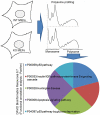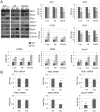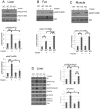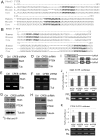Cytoplasmic polyadenylation element binding protein deficiency stimulates PTEN and Stat3 mRNA translation and induces hepatic insulin resistance
- PMID: 22253608
- PMCID: PMC3257279
- DOI: 10.1371/journal.pgen.1002457
Cytoplasmic polyadenylation element binding protein deficiency stimulates PTEN and Stat3 mRNA translation and induces hepatic insulin resistance
Abstract
The cytoplasmic polyadenylation element binding protein CPEB1 (CPEB) regulates germ cell development, synaptic plasticity, and cellular senescence. A microarray analysis of mRNAs regulated by CPEB unexpectedly showed that several encoded proteins are involved in insulin signaling. An investigation of Cpeb1 knockout mice revealed that the expression of two particular negative regulators of insulin action, PTEN and Stat3, were aberrantly increased. Insulin signaling to Akt was attenuated in livers of CPEB-deficient mice, suggesting that they might be defective in regulating glucose homeostasis. Indeed, when the Cpeb1 knockout mice were fed a high-fat diet, their livers became insulin-resistant. Analysis of HepG2 cells, a human liver cell line, depleted of CPEB demonstrated that this protein directly regulates the translation of PTEN and Stat3 mRNAs. Our results show that CPEB regulated translation is a key process involved in insulin signaling.
Conflict of interest statement
The authors have declared that no competing interests exist.
Figures







Similar articles
-
Sequential Functions of CPEB1 and CPEB4 Regulate Pathologic Expression of Vascular Endothelial Growth Factor and Angiogenesis in Chronic Liver Disease.Gastroenterology. 2016 Apr;150(4):982-97.e30. doi: 10.1053/j.gastro.2015.11.038. Epub 2015 Nov 26. Gastroenterology. 2016. PMID: 26627607
-
A molecular circuit composed of CPEB-1 and c-Jun controls growth hormone-mediated synaptic plasticity in the mouse hippocampus.J Neurosci. 2008 Aug 20;28(34):8502-9. doi: 10.1523/JNEUROSCI.1756-08.2008. J Neurosci. 2008. PMID: 18716208 Free PMC article.
-
CPEB regulation of human cellular senescence, energy metabolism, and p53 mRNA translation.Genes Dev. 2008 Dec 15;22(24):3449-60. doi: 10.1101/gad.1697808. Genes Dev. 2008. PMID: 19141477 Free PMC article.
-
Cytoplasmic Polyadenylation Element Binding Protein 1 and Atherosclerosis: Prospective Target and New Insights.Curr Vasc Pharmacol. 2024;22(2):95-105. doi: 10.2174/0115701611258090231221082502. Curr Vasc Pharmacol. 2024. PMID: 38284693 Review.
-
CPEB and translational control by cytoplasmic polyadenylation: impact on synaptic plasticity, learning, and memory.Mol Psychiatry. 2023 Jul;28(7):2728-2736. doi: 10.1038/s41380-023-02088-x. Epub 2023 May 2. Mol Psychiatry. 2023. PMID: 37131078 Free PMC article. Review.
Cited by
-
Comparison of alternative splicing (AS) events in adipose tissue of polled dorset versus small tail han sheep.Heliyon. 2023 Mar 31;9(4):e14938. doi: 10.1016/j.heliyon.2023.e14938. eCollection 2023 Apr. Heliyon. 2023. PMID: 37095997 Free PMC article.
-
CPEB1 mediates epithelial-to-mesenchyme transition and breast cancer metastasis.Oncogene. 2016 Jun 2;35(22):2893-901. doi: 10.1038/onc.2015.350. Epub 2015 Sep 28. Oncogene. 2016. PMID: 26411364 Free PMC article.
-
Essential role for non-canonical poly(A) polymerase GLD4 in cytoplasmic polyadenylation and carbohydrate metabolism.Nucleic Acids Res. 2017 Jun 20;45(11):6793-6804. doi: 10.1093/nar/gkx239. Nucleic Acids Res. 2017. PMID: 28383716 Free PMC article.
-
Cpeb4-mediated Dclk2 promotes neuronal pyroptosis induced by chronic cerebral ischemia through phosphorylation of Ehf.J Cereb Blood Flow Metab. 2024 Sep;44(9):1655-1673. doi: 10.1177/0271678X241240590. Epub 2024 Mar 21. J Cereb Blood Flow Metab. 2024. PMID: 38513137 Free PMC article.
-
A role of CPEB1 in the modulation of proliferation and neuronal maturation of rat primary neural progenitor cells.Neurochem Res. 2013 Sep;38(9):1960-72. doi: 10.1007/s11064-013-1102-4. Epub 2013 Jul 4. Neurochem Res. 2013. PMID: 23824559
References
-
- White MF, Kahn CR. The insulin signaling system. J Biol Chem. 1994;269:1–4. - PubMed
-
- Kahn SE, Hull RL, Utzschneider KM. Mechanisms linking obesity to insulin resistance and type 2 diabetes. Nature. 2006;444:840–846. - PubMed
-
- Kim JH, Kim JE, Liu HY, Cao W, Chen J. Regulation of interleukin-6-induced hepatic insulin resistance by mammalian target of rapamycin through the STAT3-SOCS3 pathway. J Biol Chem. 2008;283:708–715. - PubMed
-
- Richter JD. CPEB: a life in translation. Trends Biochem Sci. 2007;32:279–285. - PubMed
Publication types
MeSH terms
Substances
Associated data
- Actions
Grants and funding
- 2 T32 HD007312/HD/NICHD NIH HHS/United States
- P30 DK032520/DK/NIDDK NIH HHS/United States
- R01 AG030323/AG/NIA NIH HHS/United States
- 2 T32 HD007439/HD/NICHD NIH HHS/United States
- R01 HD037267/HD/NICHD NIH HHS/United States
- HD37267/HD/NICHD NIH HHS/United States
- R37 HD037267/HD/NICHD NIH HHS/United States
- AG30323/AG/NIA NIH HHS/United States
- DK32520/DK/NIDDK NIH HHS/United States
- T32 HD007312/HD/NICHD NIH HHS/United States
- U24 DK093000/DK/NIDDK NIH HHS/United States
- R01 GM046779/GM/NIGMS NIH HHS/United States
- R01 DK067493/DK/NIDDK NIH HHS/United States
- T32 HD007439/HD/NICHD NIH HHS/United States
- R01 DK080756/DK/NIDDK NIH HHS/United States
- DK80756/DK/NIDDK NIH HHS/United States
LinkOut - more resources
Full Text Sources
Other Literature Sources
Medical
Molecular Biology Databases
Research Materials
Miscellaneous

